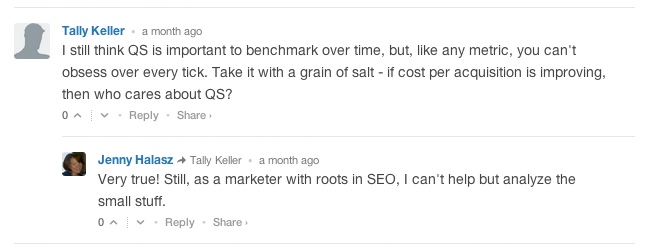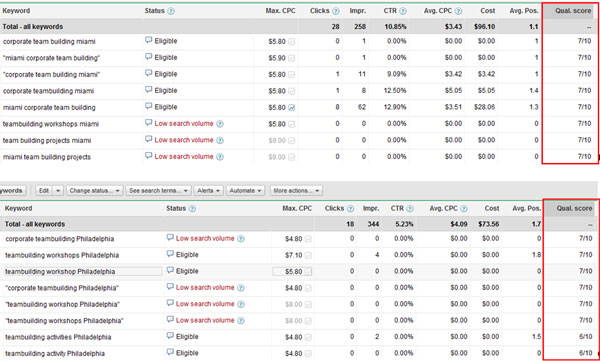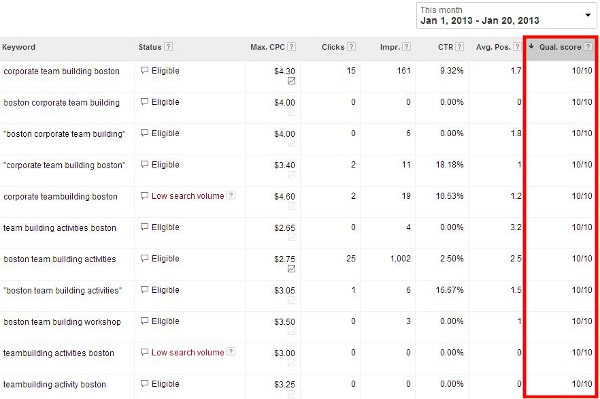As PPC account managers, Quality Score is not something we constantly track as a key metric – mainly because if you’re doing everything right with your PPC management, Quality Score should follow suit.
See, if worrying about and managing Quality Score was continuously on our agenda, then that’s very telling about how well we implement sound PPC practices.
That said, Quality Score can be a very telling metric of how well you’re implementing best practices for AdWords. I’ll give you an example. Back in 2010, we took on a client that needed some serious TLC on their Google AdWords account.
The Quality Score was very low as a result of the lack of a good account structure and keyword relevance – ones and twos on a scale of 10. But, we implemented best practices on the account and saw huge improvements.
Today, we’ll revisit this case study originally published in May 2011 right here on our PPC blog, talk about further improvements to this particular account, and discuss why Quality Score still matters as an indicator of success – at least for now.
Does Quality Score Really Matter Anymore?
There’s been a fair amount of talk that Quality Score is becoming irrelevant – a “vanity” metric, if you will. Some account managers have seen Quality Scores jump for no apparent reason. Others wonder why some Quality Scores are showing stellar 10s when there haven’t been any impressions of that keyword yet.
In the Search Engine Land article on dealing with Quality Score, commenters discussed this phenomenon:
I completely agree with Tally’s comment with one exception: when things are heading south or not progressing as you would like, you do start poking in at the details like Quality Score.
And while many PPC managers believe Quality Score is just too complicated and vague to spend time on trying to dissect, Google is actually quite straightforward about what impacts Quality Score, how Quality Score impacts your PPC campaigns and even how to improve it.
A couple takeaways from this video:
- Quality Score matters because it affects your cost per click.
- Quality Score takes into account click-through rate, relevancy and landing page quality.
Among all the new trends and developments in AdWords each year, there are certain foundations that hold true to account setup and management. Through experience comes insight into what pillars are essential for a strong AdWords account, and what trends are worth exploring.
Going back to the basics and aligning the PPC account with best practices is what we did for our client whose Quality Score was all the way down to one. In turn, we saw Quality Score improve. So we took that score as an overall indicator that we were on the right path.
Quality Score Killers: A Recap
In 2010, we started a four-part series blog post case study on a client whose account and Quality Score we revived. Many of the tactics we performed were based on the foundations of what Google would say constitutes a great AdWords campaign.
Here’s a snapshot of the client’s original Quality Scores:
And here’s a recap of what they were doing wrong:
- Extremely broad keywords, bidding on irrelevant terms that had little to do with their actual services.
- Advertising on the Display Network as well as the Search Network.
And here’s how we revived the account:
- Created a more targeted focus for the keywords along with geographic terms.
- Created city-specific landing pages for the geotargeted campaigns.
- Optimized those pages with keywords and customer testimonials.
With Google, relevancy is the name of the game. So we wanted to hyper-focus on that aspect of this campaign. The new keywords along with customized city-specific landing pages that featured useful information to the buyer created a better user experience and more relevancy in support of the ads. A win-win.
We shared the results of our efforts in Part 4 of our case study series on Quality Score:
Prior to the overhaul, impression share averaged 11.40%, now it averages at about 70%. We have seen the similar improvements with click through rate (CTR). Before it was under 0.27% and now it is over 3.7%. Cost per conversion is also much better.
And the Quality Scores? We saw improvements from ones and twos to fives and sevens:
But we weren’t finished just yet …
Continuous Quality Score Improvements as an Indicator of Success
Every account is different, but improving a campaign is a never-ending cycle. A good PPC account manager should always be keeping his or her eyes peeled for how to use the results and data to keep things moving in an upward motion.
We left off with this account case study in 2011, stating there were a few more things we wanted to tweak:
Although the account is much healthier than it was last year, we’d like to add some keyword phrases that do not include the city modifier. Even though broad match should activate our ads for phrases such as team building and team building programs, they don’t as much as we’d like. We suspect this could be due to the history of the account. We did add non city keyword phrases about a month after our launch and they were hit with our low Quality Scores of 2. We paused and tried again two months later and they started out with a Quality Score of 3, we are slowly adding more as time goes on as the account performance improves.
Since then, we kept a close watch on the original campaigns and ad groups, ensuring negative keywords were added as necessary. Further developments of the campaigns included additional targeted ad groups, ads, keywords and so on. We also focused on the click-through rate (CTR) of live keywords and Web stats.
So how did this affect the Quality Score?
Account-wide, there are minimal instances of quality scores of 3 any more. We are pleased to report that 30 percent of the account has a quality score of 10:
And back to the reason why Quality Score matters: good Quality Scores are important to lower cost per clicks. The improvement of this particular client’s account has resulted in a much lower cost per click (CPC). In January 2011, the account had and average CPC of $5.43 and in January 2013, it’s now at $2.29! That’s a 58 percent improvement!
So the next time you hear someone say “Quality Score is dead,” or you’re not quite sure how that metric really matters, remember that’s it’s usually an indicator of many different factors coming together to show how well your account is performing overall.
In the meantime, we’ll continue to monitor developments in Quality Score over here at Group Twenty Seven to determine how it plays into the success of your AdWords campaigns.











